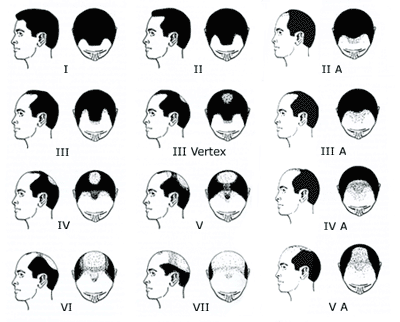Male Pattern Baldness Layton, UT
Androgenic Alopecia, also known as male-pattern baldness, is the most common cause of hair loss in men. There are three factors that play a role in androgenic alopecia.
Inherited Genes
While there is a commonly held misperception that baldness only comes from our mother’s side, this is not correct. The genes inherited come both from our mother and father that play a role in male-pattern baldness. Several genes have been implicated. An X chromosome linked gene ,EDA2R, has been shown to be highly associated with hair loss. This gene is inherited from our mother and may play a more prominent role in the early development of hair loss. This can occur as early as late teenage years. Other, non-sex linked genes have also been found to be associated with hair loss including P2RY5, Sox21 and genes on chromosome 3. These non-sex linked genes account for the variable inheritance pattern.
DHT levels.
DHT, an abbreviation for di-hyrdro-testosterone, is a breakdown product of testosterone. DHT is formed when testosterone is broken down by the enzyme 5-alpha reductase. It is a natural hormone found at high levels in men and lower levels in women. This hormone is important embryologically as it helps a male baby form genitals. However, after birth, the hormone plays no functional role. In adulthood, there are several effects of DHT, most of which are undesirable. DHT causes the prostate gland to enlarge, hair growth on one’s back and finally, makes the hair on the top of the head thin and fall out. In men with hair loss, the hair on the top of the head is sensitive to DHT, but that on the back of the head is not.
Environmental Factors.
While genetics is clearly the most important and dominant factor in determining male-pattern baldness, there may be other factors that play a role. Hair styles, wearing hats, frequency of hair washing, hair treatments including hair coloring, diet, exercise, weight loss, toxic exposure, illness, pregnancy, medications and many other environmental factors have been implicated as causes of hair loss. However, the medical evidence defining the role of various environmental factors in male-pattern baldness is not clear. It is important to understand the difference between male-pattern baldness, generally consider genetic, and other types of alopecia. The pattern is different and the treatment options also differ. Please refer to the HAIR LOSS WOMEN section for further discussion of medical causes of hair loss. An appropriate diagnosis is important as the treatment changes.
Incidence of Male-Pattern Baldness. In men, hair loss is a very common problem. Easy to remember numbers are:
- 20% of men in their 20′s are effected
- 30% of men in their 30′s
- 40% or men in their 40′s
This pattern continues even to the decade of the 90′s where virtually all men will have hair loss. It is also important to remember that even men with a “full head of hair” in middle age will have some degree of thinning and recession. Indeed, a 50 year old male with a juvenile hairline is so uncommon that it appears almost unnatural. This concept is important to remember when creating an anterior hairline. The hairline should look natural at the time that the surgery is performed, but continue to look natural as the person ages. Please see the Hair Transplantation – Frontal Hairline page for further discussion of creation of the frontal hairline.
The most important thing to remember about hair loss is that it is PROGRESSIVE. This means, that over time, hair loss will continue. The process is slow. There may be periods of time where hair loss is rapid, followed by periods of relative stability. But, the principle remains, that the course is one of progressive loss and persistent loss. When creating the frontal hair line, it is important that the frontal hair line must look natural throughout the life of the patient. Click here for further discussion of the frontal hair line creation.
The most widely accepted classification scale for male-pattern hair loss is shown below. Notice there is the regular or standard pattern that includes thinning of the crown. There is also a variant pattern of loss (the A classification) where there is minimal to no loss in the crown, but the hairline continues to advance from front to back. Both hair loss patterns are considered to be part of the spectrum of androgenic alopecia and are treated similarly.
Where do you fit on the Norwood Hair Loss Classification?



